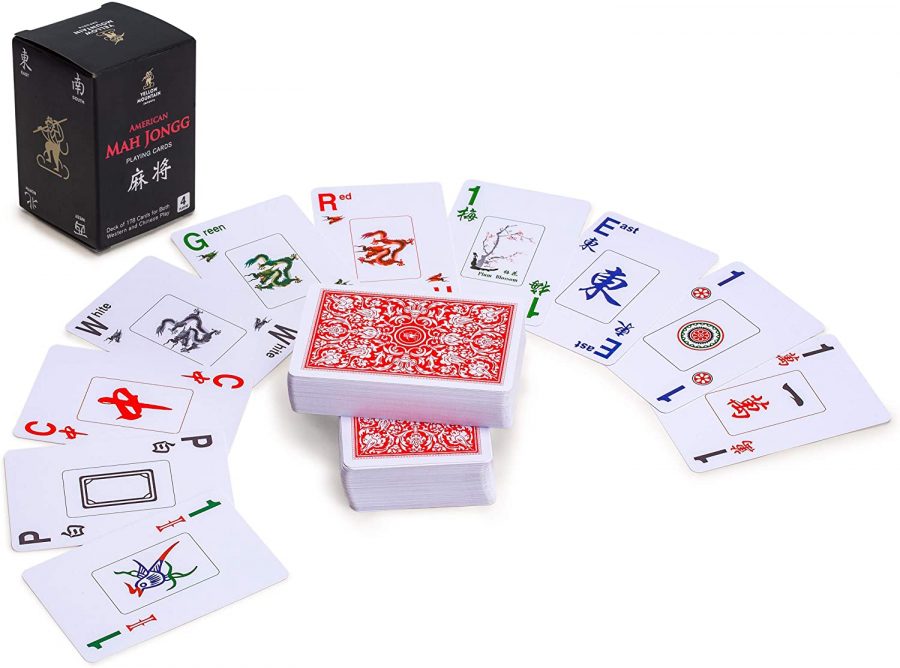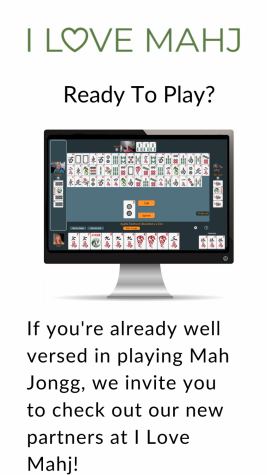This Week in Mah Jongg: Playing the Game (Part 1)
Published August 3, 2021
So far, in this tutorial series presented by I Love Mahj, we've discussed the various tiles found in an American Mah Jongg set and how to read the card published each year by the National Mah Jongg League (NMJL). As you’ll recall, the object of the game is to be the first player to form specific combinations of 14 tiles (patterns), known as hands, as shown on the NMJL’s Official Standard Hands and Rules card.
Now, it's time to play! There are several steps to a game, as well as rules of play, and we'll cover each in turn.
Setting up
When playing online, on a site such as I Love Mahj, the set-up of the game is done for you, and you can just start playing. For those playing in-person with a physical Mah Jongg set, here are the steps to set up the game:
- Arrange 4 players around a small table (such as a square card table)
- Lay a rack in front of each player, sloped side facing the player
- Place all tiles face down in the center of the table and move them around until well mixed
- Each player gathers tiles from the center of the table to build a double-tiered "wall", 19 tiles long and 2 tiles high.
- This wall is built along the front edge of a player’s rack, furthest from them, with tiles face down. Each player rolls a pair of dice and the highest scorer is designated as "East" for this particular game. East will start the game and will also have an additional tile during the Charleston, the first stage of the game. (The player to the right of East will become East for the next game and so on)
- East rolls the pair of dice again and the total score is the number of tiles they count from right to left along their wall.
- East now breaks the wall, removing the next 4 tiles (these 4 tiles are made up of the next 2 upper and next 2 lower tiles) and then places these face down on the table in front of them (between the edge of the table and their rack). The counted tiles remain on the front edge of East’s rack and will be the last tiles used in the game, assuming Mah Jongg isn’t called beforehand.
- Moving in a counter-clockwise fashion, each player takes the next group of 4 tiles (2 from the top row and 2 from the bottom row), continuing around the table until they each have 12 tiles in front of them. Note: Tiles are initially picked from East's (partial) wall, then from the next wall (in clockwise order), which is pushed out so that the far right end of the wall is placed towards the middle of the table (the far left remains close to the player’s rack). Tiles are always picked from the far right end of each wall.
- Once all players have 12 tiles, East takes 2 additional tiles from the wall (the first and third tile from the top row of the wall) and other players (in counter-clockwise order) pick 1 tile each (whichever is next - either a top or bottom row tile).
- East now has 14 tiles and the other players have 13. No tiles should be looked at prior to this point.
- Tiles can now be placed on the sloped side of a player’s rack (visible only to them) and examined.
At this point, players will begin arranging their tiles on their racks, analyzing their options, and contemplating which hands they may wish to aim for as play continues.
We’ll discuss these decisions in more detail at a later date.
The Charleston
Once everyone has had a chance to mull over their tiles, the game moves on to what’s known as The Charleston. The Charleston is unique to American Mah Jongg and involves passing unwanted tiles between players in the hope of receiving additional tiles toward a particular hand. This is achieved in the following fashion:
First Charleston (mandatory)
- All players pass 3 tiles to the player on their right
- All players pass 3 tiles to the player across from them
- All players pass 3 tiles to the player on their left. However, this time, players do not need to pass their own tiles. They should choose between 0-3 of their own tiles and any shortfall should be made up of tiles received from the player on their right. These tiles should be passed without first looking at them. This is known as a "blind pass".
A player’s tiles must always be passed before they take the tiles being passed to them. Jokers cannot be passed during the Charleston.
Second Charleston (optional)
If all four players agree, another Charleston is conducted, starting with a pass to the left this time. But if one or more players wish to stop at this point, players move directly to the Courtesy Pass (see below). The second Charleston is conducted as follows:
- All players pass 3 tiles to the player on their left
- All players pass 3 tiles to the player across from them
- All players pass 3 tiles to the player on their right. This pass can include 0-3 of their own tiles, supplemented with tiles received, as before (see note above regarding a "blind pass")
Courtesy Pass
After the first and second Charlestons have been completed (the second being optional), the game moves on to the Courtesy Pass, also referred to as the Optional Pass. This is the last pass of the Charleston. The Courtesy Pass involves only players sitting directly opposite one another. Each player tells the person opposite them how many tiles they wish to pass, which can be anywhere between zero and three tiles. A negotiation may occur at this point, if either player wishes to adjust their offer. Both players then exchange tiles equal to the lowest offer.
Once the Charleston has been completed, players move into the main part of the game and the fun really begins!
The above has given you a flavor of the very beginning of the game of American Mah Jongg. Next time, we’ll delve into the game itself!
If you haven’t already done so, don’t forget to order your Mah Jongg card from the National Mah Jongg League. You are also welcome to join our Facebook Group and Instagram using the links above. See you next time!
















